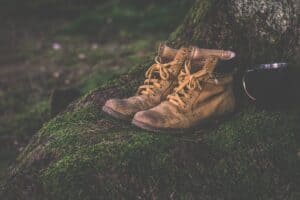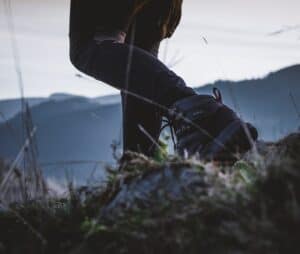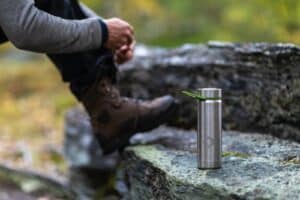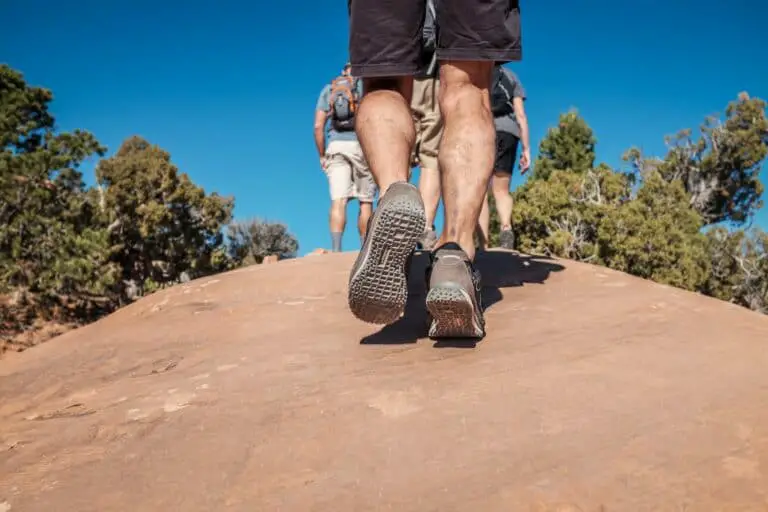When it comes to hiking, the right footwear can make or break your adventure. You might wonder, should hiking shoes be tight or loose? It’s a common question and one that we’ll delve into in this article.
The fit of your hiking shoes is crucial for comfort and performance on the trail. Too tight, and you’ll end up with blisters and sore feet. Too loose, and you risk tripping or twisting an ankle.
Benefits of a Tight Fit

When we talk about a tight fit, it’s important to understand that we aren’t referring to a compressive, uncomfortable type of tightness. Instead, a “tight” fit in hiking shoes signifies a secure connection between your foot and the shoe, allowing for optimal movement and control on the trail.
A tight fit ensures that the foot does not slide within the shoe—an essential factor considering the varied, often unpredictable nature of hiking terrain. In turn, this minimizes the likelihood of awkward foot placements and decreases the risk of slips and falls, thus promoting your overall trail safety.
Increased Stability: Hiking shoes that fit well add to the balance and stability needed to tread uncertain ground. They work alongside your innate proprioceptive capabilities (your body’s ability to recognize its position in physical space) making each step precise and confident.
Next, I’ll mention the advantages of a well-fitting shoe in terms of injury prevention. If hiking shoes are too loose, the foot can move too much, causing blisters from excessive rubbing against the shoe material. But with a snug fit, the foot stays in place, reducing the risk of these annoying and painful nuisances.
One often overlooked benefit of a properly fitting hiking shoe is the level of energy efficiency it provides. Loosely fit shoes can cause you to exert more effort in maintaining the balance and control needed to prevent missteps. On the other hand, shoes that fit tightly, but comfortably, allow you to walk naturally and efficiently, saving energy and helping you remain fresher for longer on the trail.
Lastly, it’s important to note that a tight fit aids in delivering all the technology shoes possess to the foot and trail. Be it waterproofing, breathability, or traction, a well-fitting shoe allows these features to perform at their best, enhancing your overall hiking experience.
In the next section, we’ll explore the benefits of a loose fit and how it contradicts, and in some cases complements, the benefits of a tight fit.
Drawbacks of a Tight Fit

Though there are clear benefits to a secure connection between foot and shoe, no discussion would be complete without addressing the potential downsides to a tight fit.
Incorrect sizing or overtightening can lead to discomfort and possible injuries. Often, hikers who prefer a snug fit overlook the need for some wiggle room for the toes. If your shoes are too tight at the toe box, it could lead to conditions like bunions, corns, hammer toes, and even plantar fasciitis. These conditions don’t just cause pain and discomfort, they can sideline you from your much-loved hiking activity.
Sometimes, you may not notice the tightness in your hiking shoes until you are halfway through your trail. Hiking involves diverse foot movements and navigations across uneven terrains. Your feet will elevate, descend, twist, and turn. A tight fit could hinder these movements and cause fatigue quicker.
Furthermore, proper blood circulation is vital for foot health. A tight shoe fit can constrict blood flow to the feet, leading to coldness, numbness, and potential circulatory complications. In extreme cold weather, this could escalate to a severe condition known as frostbite.
Tight hiking shoes can also cause sweat accumulation. Contrary to what one might think, sweaty feet in tight shoes could lead to faster cooling in cold weather, increasing the risk of hypothermia. Besides the chill factor, excessive sweat brings about damp conditions within the shoe, ideal for the growth of bacteria and fungi, triggering foot diseases.
Finally, let’s explore the pressure a tight fit could put on your hiking experience. An uncomfortable fit could contribute to distractions on your hike, deflecting focus away from the beauty and peace that trekking trails typically offer.
Rest assured, these potential drawbacks of a tight fit don’t entirely negate the advantages highlighted earlier. Nevertheless, understanding these challenges is the first step towards finding your perfect fit. The following section will discuss the benefits and drawbacks of a loose fit to further guide you in making an informed shoe choice for your next hike.
Benefits of a Loose Fit
A loose fit in hiking shoes may seem counterintuitive, but believe it or not, there are significant benefits to this fitting style. Let’s delve into the details and uncover the notable advantages.
Room for Swelling: As I hit the trail and my hike progresses, my feet naturally tend to swell. A loose fit accommodates this swelling without causing discomfort or restricting circulation. This is especially beneficial on long-duration hikes where feet swelling can be quite pronounced.
Movement Freedom: A loose fit allows my toes to wiggle and move freely. This free movement can ward off numbness and foot fatigue during extended ascents or descents. Also, it provides room for thermal socks in chilly weather without creating an uncomfortable tight squeeze.
Easier to Put On and Remove: I’ve often found that a loose fitting shoe is much easier to slip on and off – particularly when I’m tired after a long hike. This real convenience is an upside that is often overlooked when discussing shoe fit.
Drawbacks of a Loose Fit

While the above benefits make a loose fit an attractive option, it’s also important to discuss potential downsides. After all, as a seasoned hiker, I know every coin has two sides.
Less Stability: A loose fit may lead to less stability during hikes, particularly on uneven terrains. The lack of a tight grip could make my foot slide inside the shoe, leading to potential missteps or injuries.
Potential for Blisters: Oddly enough, while a tight fit can cause blisters due to friction, so can a loose fit. This is because my foot can slide and rub against the shoe if it’s not firmly held in place. This situation, unfortunately, can lead to painful blistering.
Inadequate Support for the Arch and Heel: Finally, a loose fit may be less beneficial for people like me who need more arch or heel support. This is because the shoe’s support mechanism may not align perfectly with my foot structure if it’s not snuggly fitted.
So, there you have it, the significant advantages and potential drawbacks of a loose fit. It’s clear that there’s no one-size-fits-all answer when it comes to shoe fitting for hiking. Each hiker has to weigh up the benefits and drawbacks according to their needs and opt for the most comfortable and efficient choice. While I find these benefits and drawbacks, the next step in our hiking shoe saga will be looking
Drawbacks of a Loose Fit
While it’s evident that a loose fit provides certain advantages, it’s equally important to highlight the potential pitfalls. Some hikers may find that a loose shoe detracts from stability, leading to twisted ankles or slips on tricky terrain.
Less Stability
Less stability is the first and most significant drawback of a loose fit. When shoes aren’t snug against the foot, the lack of a tight grip may cause your feet to slide inside. Resulting in less control and overall stability. This can be particularly problematic on uneven ground or challenging trails. Falling in hiking is not just about an embarrassing slip. It can lead to serious injuries, which can end your hiking trip prematurely.
Blisters & Other Injuries
Another drawback is the potential for blisters. When there’s too much room in a shoe, the foot can slide and rub against the inner materials. Any experienced hiker will testify, blisters can ruin even the most beautiful hikes. They are painful, they take time to heal, and they can lead to more severe complications if not treated promptly.
On top of this, the loosening of the shoe may result in not just blisters, but ankle sprains and fractures. The foot slipping inside the shoe can cause the ankle to twist awkwardly, particularly in clumsy steps or misfooting.
Inadequate Support
Loose shoes often provide inadequate support for the arch and heel, making lengthy excursions increasingly unbearable. The foot is a complex structure that deserves good support, especially when being pushed to its limits during multi-day hikes or difficult trails.
We’ve discussed the benefits and drawbacks of a loose fit. But remember, when it comes to hiking gear, it’s always a balance between comfort, support, and safety. With this in mind, finding the most comfortable and efficient shoe fit can take some trial and error. The key is to understand that a perfect fit might mean compromising on some aspects while favouring others.
Conclusion: Should Hiking Shoes Be Tight or Loose?
After exploring both sides of the coin, it’s clear that the fit of your hiking shoes is a crucial factor. While a loose fit offers room for swelling and freedom of movement, it also brings potential pitfalls like less stability and increased risk of blisters.
On the other hand, a tight fit can provide the much-needed support for your arch and heel, but it may compromise on comfort. Therefore, it’s all about striking the right balance.
Remember, the perfect hiking shoe fit isn’t necessarily tight or loose. It’s the one that offers you comfort, support, and safety. So, when you’re out there shopping for your next pair of hiking shoes, keep these factors in mind. Ultimately, your feet will thank you for it!

